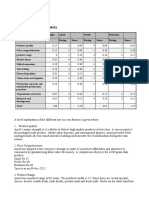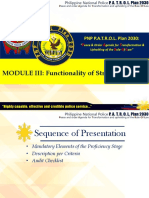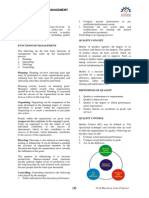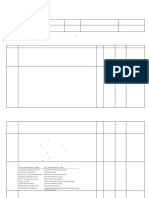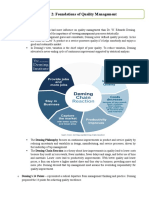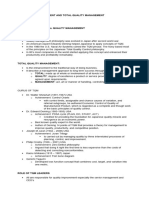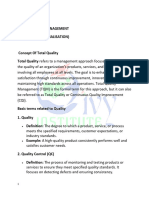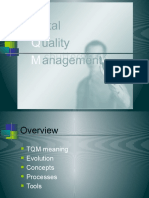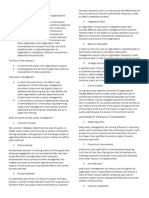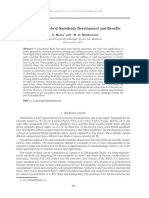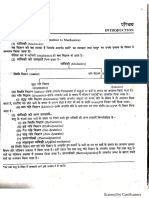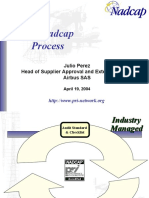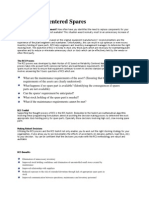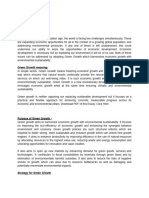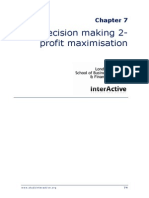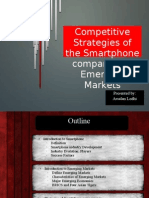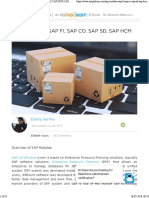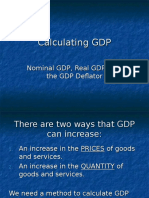Quality
Quality
Uploaded by
Er. Ramji TripathiCopyright:
Available Formats
Quality
Quality
Uploaded by
Er. Ramji TripathiOriginal Description:
Original Title
Copyright
Available Formats
Share this document
Did you find this document useful?
Is this content inappropriate?
Copyright:
Available Formats
Quality
Quality
Uploaded by
Er. Ramji TripathiCopyright:
Available Formats
NOE-072 QUALITY MANAGEMENT
QUALITY MANAGEMENT 2. Compare present performance to pre
established performance norms.
Management activities and functions involved in 3. Determine the next action plan and
determination of quality policy and its modifications for meeting the desired
implementation through means such as quality performance parameters.
planning and quality assurance (including quality Controlling is an ongoing process.
control).
QUALITY CONCEPT
FUNCTIONS OF MANAGEMENT Quality of product signifies the degree of its
excellence and fitness for the purpose. The quality
The following are the four basic functions of
management that make up the management of product means all those activity which are
process: directed to maintain and to improve. Such as
1. Planning setting of quality targets, appraisal of conformance,
2. Organizing taking corrective action where any deviation is
3. Directing noticed and planning for improvements in quality.
4. Controlling.
Planning: Planning involves choosing tasks that Quality is a measure of the user satisfaction
must be performed to attain organizational goals, provided by a product. It includes functional
outlining how the tasks must be performed, and efficiency, appearance, ease of installation and
indicating when they should be performed. operation, safety reliability, maintainability,
running and maintenance cost.
Planning activity focuses on attaining goals.
Managers outline exactly what organizations
should do to be successful. Planning is concerned DEFINITIONS OF QUALITY
with the success of the organization in the short
term as well as in the long term. 1. Quality is conformance to requirements
2. Quality is fitness for use
Organizing: Organizing can be assignment of the 3. Quality is the degree to which performance
tasks developed in the planning stages, to various meets expectations
individuals or groups within the organization. 4. Quality denotes an excellence in goods and
Organizing is to create a mechanism to put plans
services
into action.
People within the organization are given work QUALITY CONTROL
assignments that contribute to the company’s goals.
Tasks are organized so that the output of each Quality Control (QC) may be defined as: The
individual contributes to the success of operational techniques and activities that are used
departments, which, in turn, contributes to the
to fulfil the requirements for quality. Following are
success of divisions, which ultimately contributes
to the success of the organization. the three steps for QC:
1. Evaluate actual operating performance
Directing: Directing is also referred as motivating, 2. Compare actual performance to goals
leading or influencing. It can be defined as guiding 3. Act on the difference
the activities of organization members in the
direction that helps the organization move towards
the fulfilment of the goals.
The purpose of influencing is to increase
productivity. Human-oriented work situations
usually generate higher levels of production over
the long term than do task oriented work situations
because people find the latter type distasteful.
Controlling: Controlling referred to the following
roles played by the manager:
1. Gather information that measures performance
Er. Ramji Tripathi
(Mech. Engg. Depart) Asstt. Professor
2
EVOLUTION OF QUALITY CONTROL and productivity, and thus constantly decrease
costs.
The quality movement started from medieval 6. Institute training on the job.
7. Institute leadership. The aim of supervision
Europe.
should be to help people and machines and
Craftsmen organized unions called guilds in gadgets to do a better job. Supervision of
the late thirteenth century. management is in need of overhaul as well as
The product inspection started in Great Britain supervision of production workers.
in the mid 1750s and brought Industrial 8. Drive out fear, so that everyone may work
Revolution in the early nineteenth century. effectively for the company
The concept of producing interchangeable 9. Break down barriers between departments.
parts to simplify assembly was introduced in People in research, design, sales, and
1798. production must work as a team, to foresee
World War II gave birth to quality in problems of production and in use that may be
manufacturing industries and military encountered with the product or service.
application. A quality revolution in Japan 10. Eliminate slogans, exhortations, and targets
followed World War II. The Japanese became for the work force asking for zero defects and
leader in quality by the 1970s. new levels of productivity. Such exhortations
Japanese manufacturers penetrated in only create adversarial relationships, as the
American markets which affected the United bulk of the causes of low quality and low
States. The emphasis became not only on productivity belong to the system and thus lie
statistics but approaches which involved the beyond the power of the work force.
entire organization. 11. Eliminate work standards (quotas) on the
This movement led to Total Quality factory floor.
Management (TQM). Several quality standards Eliminate management by objective.
followed and one of them is ISO 9000 quality Eliminate management by numbers, numerical
system standards published in 1987. goals.
12. Remove barriers that rob the hourly worker
CONCEPT CHANGE of his right to joy of workmanship. The
responsibility of supervisors must be changed
A change concept is a general notion or approach from sheer numbers to quality.
to change that has been found to be useful in Remove barriers that rob people in
developing specific ideas for changes that lead to management and in engineering of their
improvement. There are several individuals who right to joy of workmanship. This means
made significant contributions to quality control abolishment of the annual merit rating and of
and improvement. The philosophy of W. Edward management by objective
Deming, the best known quality expert, was 13. Institute a vigorous program of education
summarised in the following fourteen points: and self-improvement.
1. Create constancy of purpose toward 14. Put everybody in the company to work to
improvement of product and service, with accomplish the transformation. The
the aim to become competitive and to stay in transformation is everybody's job.
business, and to provide jobs.
2. Adopt the new philosophy. We are in a new TQM MODERN CONCEPT
economic age. Western management must
awaken to the challenge, must learn their Total Quality Management (TQM) is the new
responsibilities, and take on leadership for concept on Quality Control. TQM deals with the
change. product in its totality. Quality is determined by the
3. Cease dependence on inspection to achieve combined effects of various departments such as
quality. Eliminate the need for inspection on a Design, Engineering, Purchase, Production and
mass basis by building quality into the product Inspection. This is basically an integrated system
in the first place. covering all quality control activities during various
4. End the practice of awarding business on phases of product development.
the basis of price tag. Instead, minimize total
cost. Move toward a single supplier for any Dimensions of Quality
one item, on a long-term relationship of loyalty
and trust. 1. Performance
5. Improve constantly and forever the system 2. Features
of production and service, to improve quality 3. Durability
4. Reliability
Er. Ramji Tripathi
(Mech. Engg. Depart) Asstt. Professor
NOE-072 QUALITY MANAGEMENT
5. Serviceability QUALITY BY DESIGN
6. Appearance
7. Uniformity Product quality is created by design. There should
8. Consistency and conformance be consideration of quality in design of a product
9. Safety which meets customers need at a price acceptable
10. Time to him.
11. Customer service
12. Comparability GENERAL CONSIDERATION FOR A GOOD
DESIGN
TQM involves all the aspects of the firm in
satisfying a customer. TQM involves: 1. Appearance
2. Functional Efficiency
1. Customer-supplier relationship based on 3. Safety
mutual trust and respect. 4. Reliability
2. Firm in-house requirements by the customer. 5. Maintainability
3. Suppliers are partners in achieving zero-defect 6. Ease of Production
situation. 7. Standardization
4. Regular monitoring of supplier processes and 8. Review of Design
products by the customer.
EVALUATION OF THE PROTOTYPE
Objectives of TQM
1. Manufacturing Drawing
a. Customer focus, customer delight/satisfaction. 2. Product Specification
b. Continuous improvement of culture of the 3. Design Changes during Production
organization.
c. Focused, continuous and relentless cost CONTROL ON PURCHASED PRODUCT
reduction.
d. Focused, continuous and relentless quality An organization needs to purchase a variety of raw
improvement. materials and products for further processing or
e. To create an organization whereby everyone is consumption. The quality of product is important
working towards making their organization the and given due consideration at the time of purchase
best business, and to capitalize on the sense of because it can affect the quality of the end product.
achievement and working in a world-class While deciding the quantity that is to be purchased,
organization. consideration is also given to the economy. Many
times, it is more economical to get some of the
An Integrated TQM Model components as per their own design manufactured
by ancillary companies.
PROCUREMENT PROCESS
Procurement process is known as purchasing
through the purchasing department.
It starts with a requisition from an employee
and ends with the payment of supplier.
EVALUATION OF SUPPLIERS
It is the process of evaluating and approving
potential suppliers by factual and measureable
assessment.
It ensures a portfolio of best-in class suppliers
is available for use.
It is a process to measure and monitor the
performance of suppliers for reducing cost,
reducing risk and for continuous improvement.
Er. Ramji Tripathi
(Mech. Engg. Depart) Asstt. Professor
4
Evaluation Process Management Responsibilities
It is the pre-qualification step within the purchasing 1. Management Commitment: Whether the top
process on the basis of which a supplier is management is committed to the development
approved or not approved. It is also known as of the quality management system.
Supplier Performance Management. This includes 2. Customer Focus: Whether the top
approval of various aspects of the supplier business management ensures that customer needs and
including: expectations are determined considering
Capacity obligations related to product including
Financials regulatory and legal requirements, converted
Organization Structure, and into requirements and fulfilled with the aim of
Performance achieving customer satisfaction.
3. Quality Policy: Has the top management
Benefits defined its Quality policy? Is it appropriate to
the purpose of the organisation, committed to
Suppliers provide high standard of products meeting requirements of customers and to
and services continual improvement, provides a framework
Suppliers offer sufficient capacity and business for establishing and reviewing quality
stability objectives, communicated and understood at
Identification and removal of hidden cost in appropriate levels in the organisation, reviewed
supply chain for continuing suitability and controlled?
4. Provision of Resources: Has the organisation
Drawbacks determined and provided in a timely manner
the resources needed to implement and
Include resources and cost commitments in improve the processes of the quality
establishing and maintaining an effective management system and to address customer
system satisfaction?
Without going through the root cause of 5. Assignment of Personnel: Whether the
supplier’s problem or inconsistent scoring may Personnel assigned responsibilities defined in
result in inaccurate assessment. the quality management system are competent
on the basis of applicable education, training,
CAPACITY VERIFICATION skills and experience.
6. Training, Awareness and Competency:
For capacity verification, following points need to Whether the organisation has established a
be verified: system for identifying competency needs of
personnel and provides training, Evaluate the
General Requirement effectiveness of the training provided, and
maintains appropriate records of education,
1. Whether the organisation has established, experience, training and qualifications of its
documented, implemented, maintained and personnel?
continually improves a quality management 7. Facilities: Has the organisation identified,
system (QMS) in accordance with the provided and maintained facilities such as
requirements of ISO 9000-2000? Workspace, Equipment, hardware and software
2. Whether the organisation has identified the and supporting services it needed to achieve
processes needed for the quality management the conformity of product?
system, determined the sequence and 8. Work Environment: Whether the
interaction of these processes, criteria and organisation has a system for identification and
methods required to ensure the effective management of human and physical factors of
operation and control of these processes, the work environment needed to achieve
ensure the availability of information conformity of product.
necessary to support the operation and 9. Planning of Realization Processes: Whether
monitoring of these processes, measures, the organisation has determined Quality
monitors and analyses these processes and objectives for the product, project or contract,
implements action necessary to achieve processes and documentation, resources and
planned results and continual improvement. facilities specific to the product verification
and validation activities, the criteria for
acceptability, and records that are necessary to
provide confidence of conformity in the
process planning for product realization.
Er. Ramji Tripathi
(Mech. Engg. Depart) Asstt. Professor
NOE-072 QUALITY MANAGEMENT
DEVELOPMENT OF SOURCES a. Selection of supplier
b. Develop pilot-run plan
The main thing is to ensure that the potential c. Develop manufacturing strategy
suppliers who show interest in the product, has 2. Pilot run
the minimum essential plant equipment and a. Validate manufacturing process against:
skilled manpower. i. Objectives in product specification
Quality engineers can set up necessary controls ii. Cost
to ensure the quality of product to be iii. Quality
maintained at acceptable level. iv. Documentation
Condition of supply should be put down in v. Tooling
writing that clearly explains the vendor the vi. Training
submission of preproduction sample or a vii. Process control
particular type of packaging etc. viii. Supplier plan and contract
The following details should be considered: ix. Internal failure analysis
o Any national or international standard 3. Production run
specification should be clearly mentioned a. Produce high quality product on time
o Materials to be approved by the purchaser b. Continue to tune the process
before taken into use c. First order manufacture
o Size of the sample, made of dispatch and d. Verification of product cost
test to be conducted on the sample should 4. Delivery to customer
be known to the vendor a. Deliver first production unit to the
o Deviations from drawing and customer
specifications or concessions on certain b. Refine manufacturing process based on:
quality requirements should be clearly i. First built
defined ii. Monitor field unit performance
o Method of acceptance should be clarified
to the vendors
o Product nomenclature, part number and METHODS OF MANUFACTURING
other details should be specified
o Warranty clauses and procedure for claims
There is a variation in the production system as per
should be clarified in details
the need of the product. Generally, production
volume is the most important issue. There are three
MANUFACTURING
methods of the manufacturing:
1. Job Shop Production,
Manufacturing involves making products from raw
2. Batch Production, and
material by various processes or operations. It is a
3. Mass Production.
complex activity, involving people having broad
range of disciplines and skills and a wide variety of
machinery, equipments etc. Characteristics of Job Shop Production
i. To meet a particular customer’s needs
ii. Lot size is small
Considerations in Manufacturing
iii. Variety is high
iv. Equipments used are general purpose and
i. Design must fully meet requirements and
flexible to meet specific customer needs
specifications of the product
v. Labour should be highly skilled
ii. Manufacturing must be by the most
vi. Eg., grinding, gear manufacturing, fabrication
economical methods in order to minimize cost
etc.
iii. Quality must be built into the product at each
stage from design to assembly
iv. Production methods must be flexible to
changing demands, types of product,
production rates, production quantities and on-
time delivery to customer
v. Strive for higher productivity by optimum use
of the resources (material, machine, energy,
capital, labour and technology)
Characteristics of Batch Production
i. For repeated customer orders
MANUFACTURING STEPS
ii. Lot size is medium and in batches
iii. For moderate variety
1. Pre-production Activity
iv. Machines and equipments are general purpose
Er. Ramji Tripathi
(Mech. Engg. Depart) Asstt. Professor
6
v. Labour should be high skilled 7. Single-minute Exchange of Die (SMED)
vi. Eg., bakery items, sports shoes, t-shirts etc. a. Reduce waste time when there is some
change in the process from old product to
new product
8. DMADV Methodology
a. Design, Measure, Analyze, Design and
Verify methodology based on the analysis
of customer demand
b. Manufacturers plan ahead and try to
design ways to avoid defects in the first
Characteristics of Mass Production place
i. For high demand items 9. SIPOC Methodology
ii. Lot size is very large a. Suppliers, Inputs, Process, Outputs,
iii. Variety may be one of its kind Customers methodology to allow
iv. Special machines, tools and equipments are manufacturers to trace the life cycle of the
used products from supplier to customer and
v. Labour skill level is moderate identify problem areas
vi. Entire plant is designed to cater a few special 10. Accelerate production
varieties of products a. Computer-aided-Design (CAD)
vii. Eg., oil refinery, chemical processing unit etc. b. Computer-aided Manufacturing (CAM)
c. Computer-controlled Machines (CCM)
d. Computer-integrated Manufacturing
(CIM)
STEPS FOR QUALITY MANUFACTURING
1. Actual Process
a. Name of the process
b. Starting and ending points
c. Inputs and outputs
TECHNIQUES OF MANUFACTURING d. Customers and suppliers
2. Areas of Improvements
1. Just-in-Time (JIT) Manufacturers a. Durability
a. To keep the process moving and schedule b. Material
supplies to arrive at the factory just-in- c. Toxicity
time for them to be used in production d. Disintegration of parts
2. Kanban 3. Solution for the problems
a. An automatic request for new supplies to a. Brainstorming
the suppliers when supplies are running b. Consultation through specialists
short c. Feedback from those who work on the
3. Just-in-Sequence (JIS) process regularly
a. Supplies arrive at the factory at the exact 4. Detailed Solution
moment they are needed within the a. The personnel necessary for making
manufacturing sequence improvements
4. Total Productivity Maintenance (TPM) b. Project cost analysis
a. To repair minor issues with the machines c. Time frame for completing the overall
to avoid stopping production improvements
5. Quick Response Manufacturing (QRM) d. How the improvement will affect rest of
a. To short the time period elapsed between the plant
customer’s request for a product and its 5. Put Plan into Action
delivery a. Involve everyone who utilize the process
6. Cellular Manufacturing in implementing the action plan
a. Factory floor is divided into different 6. Evaluate
sections or cells a. The process should have desired
b. Machines are placed in the order that effect
facilitate the material flow to the b. The problem is fixed
completion of the product c. Waste eliminated
d. Improvement within budget and time
frame
Er. Ramji Tripathi
(Mech. Engg. Depart) Asstt. Professor
NOE-072 QUALITY MANAGEMENT
Re-check any defects discovered during
INSPECTION AND CONTROL OF PRODUCT Pre-Production Inspection and confirm
that they have been rectified.
Product Quality Inspections will help to protect the
brand and the company’s reputation by minimizing Final Random Inspections
It can begin only after production has been
defective merchandise, customer complaints, non- completed and all merchandise is ready
compliant products, and late shipments. Quality and packed for shipment.
Inspections can help manufacturers: Through a statistical method set by
Ensure product safety prior to shipping industry standards, sample products to
Minimize the amount of defective verify product safety, quantity,
workmanship, function, colour, size,
merchandise packing, and more.
Reduce customer complaints due to This ensures that the product is consistent
inferior products and compliant with all country, industry,
Detect merchandise containing non- or otherwise-specified requirements and
standard or non-compliant components that no critical major or minor defects
appear.
Eliminate late shipments
Based on your specific needs throughout the Loading Supervision
manufacturing process, there are a wide variety of Closely monitor the loading process
quality inspection services. Verify product quantity, and
Ensure proper handling of the cargo.
Seal the container(s) tape as proof of
Pre-Production Inspections
compliance.
Inspection of raw materials and This significantly reduces the risk
components before production begins. associated with importing cargo.
After product samples are provided, verify
that the factory has ordered the correct QUALITY IN SALES AND SERVICES
materials, components, and accessories.
Also randomly select and inspect a sample Customer’s relationship with the company
of partially produced products for may have begun with the sale, but it’s the
potential defects, then report findings. service experience that really cements the
The technical advice necessary to improve deal.
product quality and to minimize the Customers begin to see value in the
chance of defects during production. product only after they have tasted the
entire pie of service.
During Production Inspections An efficiently managed and utilized team
They are ideal for: of after sales field technicians can
o Shipments of substantial quantities; positively impact the.
o Product lines with continuous production; They have the potential to systematically
o Strict requirements for on-time shipments;
and nurture customer loyalty, since service
o As a follow-up if poor results were found quality has a direct relationship with
during Pre- Production Inspection. customer intent to repurchase.
o Normally, it is carried out when Successful cross sell and up sell of related
10-15% of the merchandise is completed.
products is also easier if existing
At this point deviations are identified.
If any, take advice on corrective measures customers are satisfied with the support
that will ensure uniformity of product and they have received.
quality. Team of after sales field technicians have
the potential to directly contribute to
organization’s revenue stream.
Methods for establishing a quality
reputation:
Er. Ramji Tripathi
(Mech. Engg. Depart) Asstt. Professor
8
Only those product should be sold which
fully meet the customer’s requirement
Adjustments of warranty claims
Effective after sales service
GUARANTEE
A promise or assurance, especially in
writing, that something is of specified
quality, content, benefit, etc., or that it will
perform satisfactorily for a given length of
time.
An undertaking by the selling company
that it will replace the product free of cost
or refund the money if the defect is due to
improper material or faulty manufacture.
It convinces the customer about the
quality of the product.
It is a powerful sales tool.
Following information included in
guarantee card:
o Validity period
o Manufacturer’s liability
o Claim procedure
o Invalidation conditions
ANALYSIS OF CLAIMS
Claims analysis is a technique for
examining the positive and negative
consequences of design features that are
described in current or future scenarios of
use.
A “claim” is a statement of the
consequences of a specific design feature
or artifact on users and other stakeholders.
Investigation of claims involves thorough
technical knowledge of the product.
Guarantee claims may be investigated by
quality control department.
The minor claims can be settled by
regional service centres and the major
ones may be referred to the company.
Procedure for claim should be simple.
Er. Ramji Tripathi
(Mech. Engg. Depart) Asstt. Professor
You might also like
- Dmgt524 Total Quality ManagementDocument243 pagesDmgt524 Total Quality ManagementPoonam Naidu100% (7)
- Competitive Profile MatrixDocument2 pagesCompetitive Profile Matrixnancy100% (1)
- DBB 1204 Set 1 and 2Document5 pagesDBB 1204 Set 1 and 2Anchu NainaNo ratings yet
- La Cadena de Valor de Michael PorterDocument15 pagesLa Cadena de Valor de Michael PorterAraceli ParedesNo ratings yet
- Mba Operations Project Report SynopsisDocument16 pagesMba Operations Project Report SynopsisPramod ShawNo ratings yet
- Module 3 - Functionality of Strategy PartnersDocument40 pagesModule 3 - Functionality of Strategy PartnersMpsmt Dipaculao MpsNo ratings yet
- Warehouse Management SystemDocument54 pagesWarehouse Management SystemmanjupadmaNo ratings yet
- Uniti 140918010347 Phpapp02 PDFDocument8 pagesUniti 140918010347 Phpapp02 PDFBeing BanNo ratings yet
- Rme-085: Total Quality Management Unit IDocument8 pagesRme-085: Total Quality Management Unit IAnkur VermaNo ratings yet
- Eoe-072: Quality Management Unit I: Vivek Bhardwaj, Asstt. ProfessorDocument5 pagesEoe-072: Quality Management Unit I: Vivek Bhardwaj, Asstt. ProfessorVivek BhardwajNo ratings yet
- TQM Notes Unit-1Document14 pagesTQM Notes Unit-1GAURAV GUPTANo ratings yet
- Eoe-072: Quality Management Unit I: Vivek Bhardwaj, Asstt. ProfessorDocument8 pagesEoe-072: Quality Management Unit I: Vivek Bhardwaj, Asstt. ProfessorPranveer Singh PariharNo ratings yet
- Management Quality ManagementDocument7 pagesManagement Quality ManagementJasmine LimNo ratings yet
- 19MS152 TQM Question Repository With Keys RevisionDocument69 pages19MS152 TQM Question Repository With Keys Revisiondanesh200520No ratings yet
- Cbme 1 - Module 2Document4 pagesCbme 1 - Module 2Neyka YinNo ratings yet
- Dimensions of QualityDocument21 pagesDimensions of QualityMamatha RavindraNo ratings yet
- Intro To TQMDocument4 pagesIntro To TQMAlyssa PuentespinaNo ratings yet
- Qms Finals NotesDocument10 pagesQms Finals Notescarlhomertenerife18No ratings yet
- TQM IDocument67 pagesTQM IEsha ShahNo ratings yet
- 316 P16mba18 2020052401385377Document66 pages316 P16mba18 2020052401385377kkaviyatnr1998No ratings yet
- S C MDocument3 pagesS C MPhia Teo50% (2)
- Cbme 1 - Module 1Document3 pagesCbme 1 - Module 1Neyka Yin100% (1)
- PPT3-Managing QualityDocument29 pagesPPT3-Managing QualityIka FitriNo ratings yet
- ED Solved Question PaperDocument28 pagesED Solved Question PaperYashwanth KumarNo ratings yet
- Chapter 3 Gurus of Total Quality ManagementDocument15 pagesChapter 3 Gurus of Total Quality ManagementKaye Joy TendenciaNo ratings yet
- Unit 11 New Development / Techniques of Management and Management ControlDocument33 pagesUnit 11 New Development / Techniques of Management and Management ControlDhavalNo ratings yet
- Ge8077 - Total Quality Management Unit I - IntroductionDocument12 pagesGe8077 - Total Quality Management Unit I - Introductionsafina rahmanNo ratings yet
- TOTAL QUALITY MANAGEMENT MBA3Document157 pagesTOTAL QUALITY MANAGEMENT MBA3804 Shagun ThakurNo ratings yet
- Chapter 3 Gurus of Total Quality ManagementDocument9 pagesChapter 3 Gurus of Total Quality ManagementCALIPDAN, Roselyn D. (Lyn)No ratings yet
- 00 Cotnents - PMD Lovely University PDFDocument253 pages00 Cotnents - PMD Lovely University PDFNaveen ChadhaNo ratings yet
- TQM and QFDDocument19 pagesTQM and QFDtashapa100% (1)
- Construction Performance Management & Resource Optimization: Chapter Four Project Quality ManagementDocument41 pagesConstruction Performance Management & Resource Optimization: Chapter Four Project Quality ManagementhabtieNo ratings yet
- Chapter 1 Part 2 Quality TheoryDocument23 pagesChapter 1 Part 2 Quality TheoryLEE CHUN FATTNo ratings yet
- Total Quality Management in Software Development ProcessDocument15 pagesTotal Quality Management in Software Development Processshariya12No ratings yet
- 06 General Quality PrinciplesDocument3 pages06 General Quality PrinciplesKapildevNo ratings yet
- Module 1: Introduction Quality Management What Is Strategic Quality Management?Document19 pagesModule 1: Introduction Quality Management What Is Strategic Quality Management?Juned Hamid KhanNo ratings yet
- W5 Module 4 - Total Quality Management (TQMDocument17 pagesW5 Module 4 - Total Quality Management (TQMDanica Vetuz100% (2)
- Engr. Muhammad Jabbar: Lecture #1Document22 pagesEngr. Muhammad Jabbar: Lecture #1Muhammad UsmanNo ratings yet
- MODULE 5 Total Quality Management (TQM) (Autosaved)Document67 pagesMODULE 5 Total Quality Management (TQM) (Autosaved)rakshith0402No ratings yet
- TQM Mba SlidesDocument55 pagesTQM Mba Slidesnahnah2001No ratings yet
- Kmbn205 Unit 5Document27 pagesKmbn205 Unit 5akshitbhardwaj790No ratings yet
- Unit 02 Quality GurusDocument20 pagesUnit 02 Quality GurushariomNo ratings yet
- Total Quality Management: P. M. SagareDocument32 pagesTotal Quality Management: P. M. SagareDeep UmradiyaNo ratings yet
- Total Quality ManagementDocument8 pagesTotal Quality ManagementHanrika VD MerweNo ratings yet
- TQM Chapter 1 2 3 4 ReviewerDocument6 pagesTQM Chapter 1 2 3 4 ReviewerNicole ArcayaNo ratings yet
- History of Total Quality ManagementDocument11 pagesHistory of Total Quality Managementguru prasadNo ratings yet
- 1 Introduction PDFDocument42 pages1 Introduction PDFMarah Abu ShakraNo ratings yet
- Total Quality ManagementDocument11 pagesTotal Quality ManagementMariesz PleytoNo ratings yet
- Om2 Project GRP 1Document24 pagesOm2 Project GRP 1Utkarsh VikramNo ratings yet
- FEIGENBAUM + Ishikawa + TaguchiDocument7 pagesFEIGENBAUM + Ishikawa + Taguchiaulia rakhmawatiNo ratings yet
- TQM, Principles EtcDocument6 pagesTQM, Principles EtcAumNo ratings yet
- TQM IntroductionDocument32 pagesTQM Introductionshivashankar sgNo ratings yet
- TQM - HeteroDocument114 pagesTQM - HeteroKartik Muppirisetty0% (1)
- Assignment NO.2: Abdul Moiz Asim Aziz Aqib Arif Binyameen Aslam Huba RanaDocument12 pagesAssignment NO.2: Abdul Moiz Asim Aziz Aqib Arif Binyameen Aslam Huba RanaRana_hubaNo ratings yet
- Juran Trilogy 1986Document9 pagesJuran Trilogy 1986Ponnuswamy pkNo ratings yet
- Introduction PDFDocument3 pagesIntroduction PDFJohn Michael PesconesNo ratings yet
- Implementation of Total Quality Management (TQM) in Indian IndustryDocument4 pagesImplementation of Total Quality Management (TQM) in Indian Industryswathi krishnaNo ratings yet
- THOUGHT CHPTER SEVEN ThoughtDocument24 pagesTHOUGHT CHPTER SEVEN ThoughtJulianNo ratings yet
- Revisi PPT3-Managing QualityDocument28 pagesRevisi PPT3-Managing QualityAbdul GhoniNo ratings yet
- QPI Chapter 2 SlidesDocument28 pagesQPI Chapter 2 SlidesLemon MoyoNo ratings yet
- Total Quality Management (May June 2013) : 1. List Any Four Dimensions of QualityDocument12 pagesTotal Quality Management (May June 2013) : 1. List Any Four Dimensions of QualityVelmurugan ThiagarajanNo ratings yet
- ME Attendence Record Second YearDocument28 pagesME Attendence Record Second YearEr. Ramji TripathiNo ratings yet
- Hydraulic, Thermodynamics Economic AnalysisDocument34 pagesHydraulic, Thermodynamics Economic AnalysisEr. Ramji TripathiNo ratings yet
- M Tech R and Ac R15 SyllabusDocument37 pagesM Tech R and Ac R15 SyllabusEr. Ramji TripathiNo ratings yet
- Mathematical Modelling of Solid Desiccant Systems: Anna PacakDocument8 pagesMathematical Modelling of Solid Desiccant Systems: Anna PacakEr. Ramji TripathiNo ratings yet
- Covid-19 Vaccination Microplan Date - (12-04-2021) - टीका उत्सव District: Kanpur NagarDocument7 pagesCovid-19 Vaccination Microplan Date - (12-04-2021) - टीका उत्सव District: Kanpur NagarEr. Ramji TripathiNo ratings yet
- Overview of Hybrid Nano Uids Development and Benefits: A. A. Minea and M. G. MoldoveanuDocument8 pagesOverview of Hybrid Nano Uids Development and Benefits: A. A. Minea and M. G. MoldoveanuEr. Ramji TripathiNo ratings yet
- Apc PaperDocument2 pagesApc PaperEr. Ramji TripathiNo ratings yet
- Dehumidification Process by Desiccant Wheel in Air ConditioningDocument3 pagesDehumidification Process by Desiccant Wheel in Air ConditioningEr. Ramji TripathiNo ratings yet
- Ijme - Raft1005 Pages 1Document2 pagesIjme - Raft1005 Pages 1Er. Ramji TripathiNo ratings yet
- 2.7 NotesDocument2 pages2.7 NotesEr. Ramji TripathiNo ratings yet
- Apc 1 1Document72 pagesApc 1 1Er. Ramji TripathiNo ratings yet
- Computer Graphics Notes-WatermarkDocument55 pagesComputer Graphics Notes-WatermarkEr. Ramji TripathiNo ratings yet
- Procedure To Activate 1 GB Data For StudentDocument1 pageProcedure To Activate 1 GB Data For StudentEr. Ramji TripathiNo ratings yet
- Applied Mechanics Book PDFDocument195 pagesApplied Mechanics Book PDFEr. Ramji TripathiNo ratings yet
- Projects - Research - Mechanical Engineering - IIT Patna PDFDocument5 pagesProjects - Research - Mechanical Engineering - IIT Patna PDFEr. Ramji TripathiNo ratings yet
- Contentfile 24329Document30 pagesContentfile 24329Er. Ramji TripathiNo ratings yet
- Information Bulletin Direct PHD Programme For B.Tech/Be Graduates July Admission 2021-22Document26 pagesInformation Bulletin Direct PHD Programme For B.Tech/Be Graduates July Admission 2021-22Er. Ramji TripathiNo ratings yet
- Vishal Nadcap Process - JulioDocument33 pagesVishal Nadcap Process - JulioEr. Ramji TripathiNo ratings yet
- Automobile Air Condition System Using Exahust GasDocument19 pagesAutomobile Air Condition System Using Exahust GasEr. Ramji TripathiNo ratings yet
- Edpm Tabular WorkDocument8 pagesEdpm Tabular WorkEśho MohamedNo ratings yet
- Reliability Centered SparesDocument2 pagesReliability Centered SparesMoustafa HelmyNo ratings yet
- IIMK Preparatory Knowledge BuilderDocument37 pagesIIMK Preparatory Knowledge Builderaparna jethaniNo ratings yet
- Goals of A Supply ChainDocument5 pagesGoals of A Supply ChainMohammad HaroonNo ratings yet
- Simm. MarshallDocument10 pagesSimm. Marshallvishnu chandNo ratings yet
- Essay - Green GrowthDocument2 pagesEssay - Green Growthmsmalik061No ratings yet
- Ma Geography Sem I P 104Document130 pagesMa Geography Sem I P 104Good Anony7No ratings yet
- Hand' Made in India: Tribal Sustainopreneurs of Change and ProsperityDocument15 pagesHand' Made in India: Tribal Sustainopreneurs of Change and Prosperityahmed alnahalNo ratings yet
- 09 Chapter 3Document40 pages09 Chapter 3kaviyaNo ratings yet
- Consummerism & It's ConsequencesDocument2 pagesConsummerism & It's ConsequencesIryna KhomaNo ratings yet
- Cima c04 2013 Class Chapter 7 Profit MaximisationDocument8 pagesCima c04 2013 Class Chapter 7 Profit MaximisationMir Fida NadeemNo ratings yet
- Income From Salary Final SEM 3Document49 pagesIncome From Salary Final SEM 3Baleshwar ChauhanNo ratings yet
- Bearing The Burden of DSTDocument3 pagesBearing The Burden of DSTchris cardinoNo ratings yet
- Housing For Urban Poor: Scenario and Solutions For IndiaDocument25 pagesHousing For Urban Poor: Scenario and Solutions For IndiaShubhamNo ratings yet
- Central University of South Bihar: Assignment of Money and BankingDocument24 pagesCentral University of South Bihar: Assignment of Money and Bankingnirshan rajNo ratings yet
- NSRs Final 2020 Publication - Updated CoverDocument72 pagesNSRs Final 2020 Publication - Updated Coveramirkhakzad498No ratings yet
- Cloth-Final Sending For PublicationDocument19 pagesCloth-Final Sending For Publicationfasika chekolNo ratings yet
- A Study On Investors Preferences Towards Various Investment Avenues in Capital Market With Special Reference To DerivativesDocument10 pagesA Study On Investors Preferences Towards Various Investment Avenues in Capital Market With Special Reference To Derivativesmehul_mistry_30% (1)
- Comepetitive Strategies of Smart Phone Companies in Emerging MarketsDocument36 pagesComepetitive Strategies of Smart Phone Companies in Emerging MarketsFaiza Shah0% (1)
- Overview of Sap ModulesDocument10 pagesOverview of Sap ModulesRAJLAXMI THENGDINo ratings yet
- Chapter 1 Performance Management and Reward SystemDocument3 pagesChapter 1 Performance Management and Reward SystemDeviane CalabriaNo ratings yet
- Calculating GDP DeflatorDocument22 pagesCalculating GDP Deflatornikowawa100% (1)
- Sample Intro and RRLDocument19 pagesSample Intro and RRLeli broquezaNo ratings yet
- Total Quality Management (RME 085) Unit-V Just-in-Time (JIT)Document4 pagesTotal Quality Management (RME 085) Unit-V Just-in-Time (JIT)Sandeep ChhabraNo ratings yet
- Plant Maintenance EngineeringDocument7 pagesPlant Maintenance EngineeringSandeep Singh KharbNo ratings yet
- Dairy Demonstration and Experimental Farm in Vietnam: MashavDocument8 pagesDairy Demonstration and Experimental Farm in Vietnam: MashavVivek SharmaNo ratings yet

